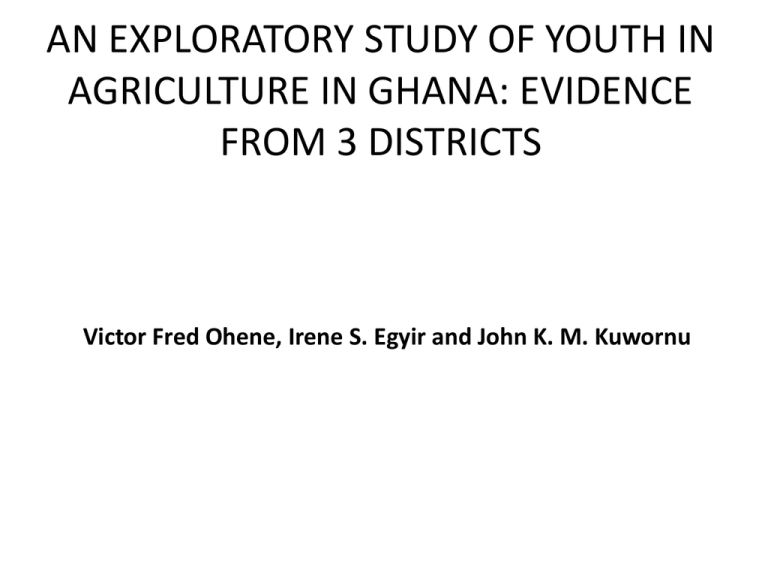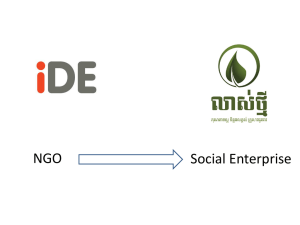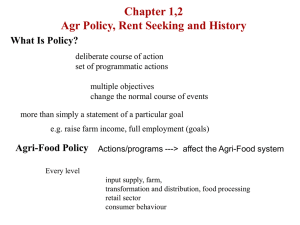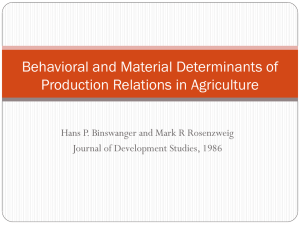an exploratory study of youth in agriculture in ghana
advertisement

AN EXPLORATORY STUDY OF YOUTH IN AGRICULTURE IN GHANA: EVIDENCE FROM 3 DISTRICTS Victor Fred Ohene, Irene S. Egyir and John K. M. Kuwornu OUTLINE OF PRESENTATION • • • • • • • • • Background of study Research problem Research objectives Methodology Results Key findings Conclusions Recommendations References Background of the study • Agriculture is one of the pillars of Ghana’s economic growth, contributing an average of 28% to GDP from 2008 to 2012 (ISSER, 2011; MoFA, 2011; IOM, 2012). • Agricultural activities usually represent the main source of employment in the rural areas because most rural households are farmers and their main source of food and income is from agricultural activities (World Bank, 2010; Abdul-Hakim and CheMat, 2011; IOM, 2012). • As such, the government of Ghana considers agricultural production as an immediate source of employment for the youth, especially those in the rural areas (MoFA, 2011). 3 Background continued • The government of Ghana (GoG) established the National Youth Employment Programme (NYEP) in 2006 to train and provide employment opportunities for the youth (MoFA, 2011). • In 2009, the GoG introduced the Youth in Agriculture Programme (YIAP) as a module to buttress the efforts of the NYEP in providing employment for the youth (MoFA, 2011). • The YIAP serves to mobilize the youth to take up agricultural related activities as a life time vocation (MoFA, 2011). 4 Background continued The YIAP has 4 main components namely; crops/block farm, livestock and poultry, fisheries/aquaculture, and agribusiness. Its objectives include the following; • To make the youth accept farming as a commercial business venture • To generate appreciable income to meet farmers’ domestic and personal needs • To help the youth enhance their standard of living though improved income • To motivate the youth to stay in rural areas, as inputs will be delivered at their farm gate on credit and interest-free basis Background continued • This study focuses on the crop/block farm system because crop farmers have the highest incidence of poverty in Ghana (about 59%) (GSS, 2012) • The inputs provided under the crop/block farm system included land; tractor services for land preparation; irrigation and mechanization facilities; quality planting materials (improved seed); fertilizer subsidies; pesticides etc • The services provided include training; extension information, technical support and marketing avenues (MoFA, 2009). 6 Research Problem • Youth are young people between the ages of 15 and 35 years (MoFA, 2011); and over 50% of Ghana’s population is below 30 years (GSS, 2000; IOM, 2012). • The estimated unemployment rate among the youth aged 15-24 years in Ghana is 25.6%; twice that of the 25-44 age group, and thrice those aged 45-64 years (GSS, 2008, IOM, 2012). • Agriculture employs about 41.6% of the economically active population aged 15 years or older (GSS, 2012). Of the 45.8% of agricultural households in Ghana, 95.1% are engaged in crop farming as compared to 40.5% in livestock rearing and 1.1% in tree growing (GSS, 2012). 7 Research Problem continued • However, the food crop farmers have the highest incidence of poverty among the agricultural households, rising from 49% in 2008 to 59% (GSS, 2012). • Several factors including lack of access to markets, high cost of inputs and low levels of economic infrastructure account for this outcome. • The youth are less willing to engage in agriculture as their main occupation because they perceive it as providing low income. They also hold the perception that agriculture is meant for the rural poor, the uneducated and unskilled persons (MoFA, 2011). • The GoG provided incentives and it is expected that the youth will respond positively and so, there will be high level of participation.8 Research questions • The main problem of this study is whether or not the incentive package (inputs and services) provided through the YIAP is influencing participation of the youth in agriculture • The specific questions that will help in answering the research question include: i. What is the level of participation by different categories of young farmers in the YIAP? ii. What factors determine participation in the YIAP in the study area? iii. What are the constraints that deter the youth from participating in the YIAP? 9 Objectives • The main objective of the study is to determine the effect of incentive packages on the youth’s participation in the YIAP • The specific objectives are: i. To estimate the level of participation by different categories of young farmers ii. To identify the constraints that deter the youth from participating in the YIAP iii. To estimate the factors that determine participation in the YIAP in the study area 10 Method of Data Analysis Objective i: Level of participation by different categories of youth farmers - Descriptive statistics was used Objective ii: Constraints that deter the youth from participating in the YIAP - Graphical representation was employed Objective iii: Factors that determine participation in the YIAP in the study area - Logit model was used to analyze the relationship between selected socio-economic, institutional and technical factors 11 Variable Description and Measurement VARIABLE DESCRIPTION UNIT OF MEASUREMENT EXPECTED SIGN AGE Age of respondent Years AGE 1 Age between 15-25 Dummy (if b/n 15-25 =1; else = 0) +/- AGE 2 Age between 26-35 Dummy (if b/n 26-35 = 1; else = 0) + AGE 3 Age between 36-49 Dummy (if b/n 36-49 = 1; else = 0) +/- GEN Gender Dummy (male = 1; else = 0) +/- EDU Education Years + MARI Marital status Dummy (married = 1; else = 0) +/- HHSIZE Household size Actual number + FAMHD Family head Dummy (head=1; else = 0) + DEPST Dependence status Dummy (independent =1; else = 0) +/- POCCU Parent’s occupation (farmer) Dummy (at least one =1; else = 0) + + 12 Variable Description and Measurement continued EXPECTED SIGN VARIABLE DESCRIPTION UNIT OF MEASUREMENT DLAND Difficulty in acquiring land Dummy (If yes =1; else = 0) - FSIZE Farm size Acres + DYIAP Distance to YIAP site/farm km - LOCEFF Effect of Location Dummy (If near govt land=1; else= 0) + FEXP Farming experience Years - FINCOM Farm income GHC + CREDASS Access to credit Dummy (If yes =1; else = 0) + OTHLIHD Other sources of livelihood Dummy (If yes =1; else = 0) - ADVERT Effect of advertisement Dummy (If yes =1; else = 0) +/- MIGR Decision to migrate to Accra Dummy (If yes =1; else = 0) - FBO Membership of an FBO Dummy (If yes =1; else = 0) + PERC Perception about farming Dummy (If neg. =1; else = 0) - Data and Sampling Procedure • Primary data was used in this study. This was collected through a field survey across 3 districts in the Eastern region • A multi-stage sampling technique was used in this study – three districts purposively selected for the study – the next stage involved identifying communities where any of the YIAP activities were being implemented – the final stage involved randomly selecting 152 farmers from the identified communities 14 Map of Study Area Socio-economic characteristics Characteristic Frequency Percentage Age 15 - 25years 26-35years 36-49 years Total 14 97 41 152 9.0 64.0 27.0 100.0 Gender Male Female Total 128 24 152 84.2 15.8 100.0 Marital status Single Married Divorced Widow(er) Total 56 91 4 1 152 36.8 59.9 2.6 0.7 100.0 16 Socio-economic Characteristics continued Characteristic Frequency Percentage Level of education No education Primary education JHS/MSLC SHS Tertiary Technical/Vocational Total 7 6 93 30 8 8 152 4.7 3.9 61.2 19.7 5.3 5.3 100.0 Family head Yes No Total 97 55 152 63.8 36.2 100.0 Household size Small (< 5 members) Large ( ≥ 5 members) Total 51 101 152 33.6 66.4 100.0 17 Summary Statistics of Continuous Variable Variable Minimum Maximum Mean Age 20 49 32.38 Age of participants 20 48 32.48 Age of nonparticipants 21 49 32.23 Household size 1 12 5.49 Farm size (acres) 1 15 5.49 Farm income (GH₵) (annual) 520.00 5, 000.00 2, 010.55 Farm income (participants) 1, 050 5, 000.00 2, 357.58 Farm income (non-participants) 520.00 3, 500.00 1, 478.42 18 Level of participation in the YIAP Characteristics Participation in the YIAP Yes No Total Participation by Age AGE1 (15-25) AGE2 (26-35) AGE3 (36-49) Total Participation by Gender Male Female Total Mode of participation Individual Group Block farm Total Frequency Percentage 92 60 152 60.5 39.5 100.0 8 54 30 92 5.3 35.5 19.7 60.5 76 16 92 82.6 17.4 100.0 55 16 21 92 36.2 10.5 13.8 60.5 19 Constraints to Participation in the YIAP 35 30 30 26 Percentage 25 20 17 15 10 10 8 5 5 4 0 Constraints to participation Difficulty in acquiring land for farming The small size of land for blockfarm The small quantities of inputs supplied The late arrival of inputs and services Difficulty in acquiring credit/loan Low level of income derived Long distance to YIAP site/land 20 Logit model estimates for determinants of participation in YIAP Variable Age of respondent Coefficient Std. error P-Value Marginal Effect -0.3933** 0.1989 0.048 -0.0438 Age 2 1.7522 2.1370 0.412 Age 3 4.9835 3.7219 0.181 Education 0.7298** 0.2870 0.011 0.0812 Household size 0.9767** 0.4883 0.045 0.1087 Parents’ occupation -0.4956 1.5546 0.750 Farm size 1.4622** 0.6458 0.024 0.1627 Effect of location 3.2107** 1.5800 0.042 0.5537 Distance from residence to YIAP site -1.3277** 0.5207 0.011 -0.1477 Difficulty in acquiring land -2.5499 1.7717 0.150 F arm income 0.0022** 0.0010 0.023 0.0002 21 Logit Model Estimates continued Variable Coefficient Std. error P-Value Access to credit 6.3542*** 2.0490 0.002 Other sources of income -1.5342 1.2228 0.210 Membership of an FBO 2.5481* 1.3615 0.061 Perception -0.4400 1.5389 0.775 Decision to migrate to Accra 2.3824 1.6091 0.139 6.9947 0.055 Constant -13.4106 Marginal Effect 0.8973 0.2324 - Log likelihood = -18.9509; Number of obs = 152; LR chi2(16) = 166.03 Prob > chi2= 0.0000; Pseudo R2= 0.8141 ***, **, and * denote 1%, 5%, and 10% significance levels respectively 22 Key findings • About 60.5% of respondents participated in the YIAP • About 35.5% of participants were aged between 26-35 years and only 5.3% of participants were between 15 - 25 years • About 82.6% of participants were males while 17.4% were females. • About 36.2% of participants participated on individual basis, 10.5% participated in groups and 13.8% participated in block farms • Education, household size, farm size, farm income, location, access to credit and membership of an FBO positively affect participation, while age and distance from farmers’ residence, negatively affect participation in the YIAP 23 Conclusions • There is moderate level of youth farmers’ participation in the Youthin-Agriculture programme in the study area • There is low level of participation for females and farmers between 15-25 years • Most youth farmers participated on individual basis rather than in groups and block farm system • Age, education, household size, farm size, membership of an FBO, farm income, access to credit, location and distance from the farmers’ residence to YIAP site/farm, were the determinants of participation in the YIAP. 24 Recommendations • MoFA, District Agricultural Development Units (DADU) and YIAP coordinators should sensitise the youth on the incentive package and the benefits to be derived from participating in the YIAP to induce participation among the youth • Government, MoFA and YIAP coordinators in the various districts should develop strategies to target; – improving the literacy levels of farmers and the youth through workshops, seminars and other training programmes – increasing the farm size of farmers in areas where the youth/young farmers farm on government acquired lands by giving participants larger plots. A farmer requires about 2.5 Ha/10acres of land to be able to able to make decent income/living from farming. 25 Recommendations continued • Government and other stakeholders must also: – encourage farmers to join FBOs/farmer groups – increase access to credit facilities such as quantities of farm inputs supplied to participants and training the youth on how to reduce post harvest losses or store and market their produce in order to improve their farm income – acquire more lands for the YIAP from traditional rulers, chiefs and other individual land owners and as close as possible to farmers’ communities. 26 References Abdul-Hakim and Che-Mat (2011).Determinants of Farmer’s Participation in Off-Farm Employment: A Case Study in Kedah Darul-Aman, Malaysia, Asian Journal of Agricultural and rural Development,1 (2), 27-37 GSS. (2000). Population and Housing Census: Summary Report of Final Results.Accra:Ghana Statistical Service GSS. (2008). Ghana Living Strandards Survey, Reports of the ifth Round, 1-5.Accra: Ghana Statistical Service GSS (2012). 2010 Population & Housing Census: Summary Report of Final Results.Accra: Ghana Statistical Service International Organization for Migration (2012, October). Country Fact Sheet, Ghana. Institute of Statistical, Social and Economic Research [ISSER], (2011).The State of the Ghanaian Economy in 2010.Legon: University of Ghana MoFA (2009). Food and Agriculture Sector Development Policy (FASDEP II).Accra: Ministry of Food and Agriculture MoFA.(2011). Youth in Agriculture Programme: Policy, Strategy and Sustainability. Accra:MoFA. World Bank. (2010). Governemnet's Role in Attracting Viable Agricultural Investment: Experience from Ghana, Accra. The World Bank Annunal Bank Conference on 27 Land Policy and Administration. Washington DC: World Bank THANK YOU FOR YOUR ATTENTION 28







